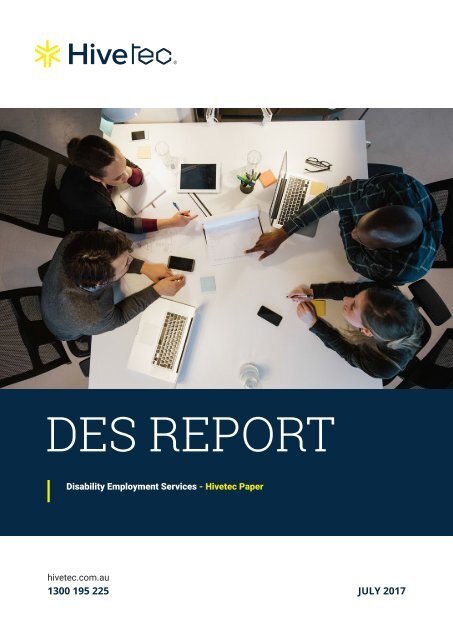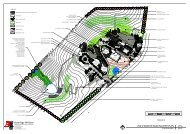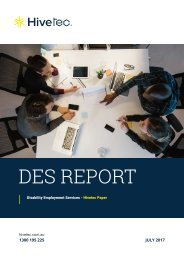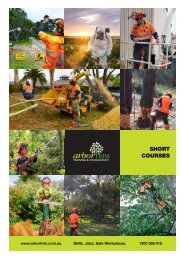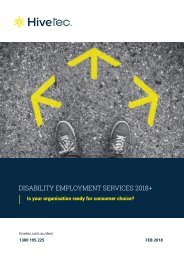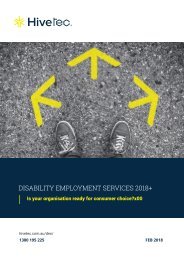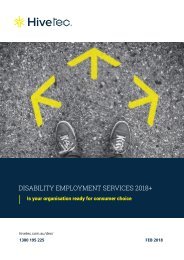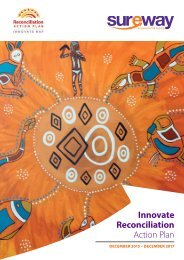Hivetec-DES-Report-V1.3
Create successful ePaper yourself
Turn your PDF publications into a flip-book with our unique Google optimized e-Paper software.
<strong>DES</strong> REPORT<br />
Disability Employment Services - <strong>Hivetec</strong> Paper<br />
hivetec.com.au<br />
1300 195 225<br />
JULY 2017
KEY STATISTICS<br />
INTRODUCTION<br />
& CONTEXT<br />
Roberts Consulting was<br />
commissioned by <strong>Hivetec</strong> to<br />
undertake a review of the<br />
recently published Disability<br />
Employment Services Reform<br />
(2018) Industry Information<br />
Paper.<br />
The purpose is to provide<br />
detailed analysis regarding<br />
the impact of the proposed<br />
changes on the <strong>DES</strong> provider<br />
network from 2018 and<br />
beyond.<br />
Disability Employment<br />
Services (<strong>DES</strong>) is the Australian<br />
Government’s specialised<br />
employment service for people<br />
whose disability is assessed as the<br />
main impediment to them gaining<br />
employment. It plays an important<br />
role in improving the social and<br />
economic participation of people<br />
with disability.<br />
ANNUAL<br />
PARTICIPANTS IN <strong>DES</strong><br />
180,000+<br />
<strong>DES</strong> PROVIDERS WHO<br />
ARE ALSO JOBACTIVE<br />
PROVIDERS<br />
28<br />
COMMENCEMENT<br />
PER MONTH APPROX<br />
7,900<br />
<strong>DES</strong> PROVIDERS IN TOTAL<br />
119<br />
INCREASE IN <strong>DES</strong><br />
PARTICIPANT LAST 6 YEARS<br />
70%<br />
<strong>DES</strong> SITES THAT ARE ALSO<br />
JOBACTIVE<br />
411<br />
<strong>DES</strong> SITES THAT<br />
DELIVER BOTH <strong>DES</strong>-<br />
DMS AND <strong>DES</strong>-ESS<br />
573
IMPROVING THE PERFORMANCE OF THE <strong>DES</strong> PROGRAM<br />
Over the next four<br />
years, the Australian<br />
Government will be<br />
investing more than $3<br />
billion in (<strong>DES</strong>) Services<br />
and its associated<br />
supports to help people<br />
with a disability find,<br />
secure and keep a job.<br />
IMPROVEMENTS<br />
The Government has been working with the sector to find ways to improve the performance of<br />
the <strong>DES</strong> program over an extended period. They argue that more people with disability should<br />
achieve the social, emotional and financial benefits that work brings.<br />
Currently <strong>DES</strong> provision is delivered by a range of providers (119) in total, these providers<br />
are a range of for profit and not for profit entities. Services are delivered from almost<br />
(2000) sites across (110) Employment Service Areas. More remote services are delivered<br />
under the Premier and Cabinet contracts via the Community Development (CDP) program.<br />
<strong>DES</strong> has two uncapped demand-driven programs, <strong>DES</strong>-Disability Management Service (<strong>DES</strong>-DMS) and<br />
<strong>DES</strong>-Employment Support Service (<strong>DES</strong>-ESS).<br />
<strong>DES</strong>-DMS<br />
Provides services to eligible job seekers with<br />
disability, injury or health condition who need<br />
assistance to find a job and occasional support in<br />
the workplace to keep a job.<br />
<strong>DES</strong>-ESS<br />
Provides assistance to eligible job seekers with<br />
permanent disability to find a job and who need<br />
regular, ongoing support in the workplace to keep<br />
a job.<br />
1<br />
ESAs do not currently include more remote areas of Australia. Services in remote areas are currently managed via the Department of Premier and Cabinet’s Community<br />
Development Program (CDP).<br />
Disability Employment Services <strong>Hivetec</strong> Paper<br />
3
<strong>DES</strong><br />
COMBINED<br />
Combined, both programs deliver a suite of employment services to people with disability,<br />
injury or health condition who are looking for work in the open labour market. Referrals to the<br />
program are dominated by Centrelink accounting for almost 91% of all transfers, further 8%<br />
are sought via self-attachments known as direct registration and the remaining 1% is gathered<br />
via Work Assist (previously Jobs In Jeopardy). Over 180,000 people around Australia use <strong>DES</strong><br />
services every year. The market currently engages approx. 93,000 commencements per year,<br />
generating approximately 50,000 job placements. Disappointingly not everyone who gets a<br />
job through the current <strong>DES</strong> systems stays in employment, the long-term outcome rates have<br />
declined over recent years.<br />
The role of <strong>DES</strong> providers is clear, to provide tailored assistance to participants to find<br />
sustainable employment. To do this they are expected to build lasting linkages and develop<br />
local relationships with employers, assisting them to negotiate the complex web of financial<br />
products and incentives they can obtain. Participant skills development is equally critical as<br />
is connecting participants with ancillary support services. Ancillary services in this context<br />
are designed to meet some specific medical needs for an individual focused on their return<br />
to work. Such services can and often include psychologists and or other support services<br />
targeted at the individuals need in overcoming physical or mental disability.<br />
Participants in <strong>DES</strong> programs crucially must also satisfy the governments mutual obligation<br />
agenda. People on some types of income support are required to actively look for work to<br />
“justify” their assistance payments to the electorate. Providers are tasked with policing the<br />
conditionality.<br />
However, unemployment for People with Disability is an intricate network of causes and<br />
consequences which require a range of responses. This support should be tailored to each<br />
individual and their experience. Providers will need to become more skilled at tailoring support<br />
to the individuals by aligning the job outcomes with their goals and ambitions.<br />
4
TRANSFORMATION MARKETPLACE<br />
The 2018 <strong>DES</strong> Discussion Paper<br />
The 2018 <strong>DES</strong> discussion paper represents a transformational market, persistent key<br />
themes have been raised as deficient in the current system over an extended period, and 2018 will display<br />
significant change to the provider network.<br />
The six primary areas targeted at improving <strong>DES</strong>, applicable to both <strong>DES</strong>-Disability Management Services<br />
(<strong>DES</strong>-DMS) and <strong>DES</strong>-Employment Support Services (<strong>DES</strong>-ESS), are outlined below:<br />
Increasing participant<br />
choice and control<br />
in the services they<br />
need<br />
Driving greater<br />
competition and<br />
contestability in <strong>DES</strong><br />
Aligning incentives<br />
to support better<br />
outcomes<br />
PAGE 08<br />
PAGE 10<br />
PAGE 12<br />
Improving the gateway<br />
and assessment<br />
process for <strong>DES</strong><br />
participants<br />
PAGE 14<br />
Better targeted<br />
assistance in the<br />
workplace<br />
PAGE 15<br />
Improved Employer<br />
engagement,<br />
Education and<br />
ongoing relationships<br />
PAGE 17<br />
These changes aim to build on the strengths of the current system while<br />
maintaining stability for participants, employers and providers.<br />
hivetec.com.au<br />
5
HOW PROVIDERS WILL<br />
LIKELY NEED TO OPERATE<br />
<strong>DES</strong> SERVICES POST 2018<br />
REFORMS<br />
The 2018 reforms will cause substantial upheaval for the sector, with significant regulatory<br />
and payment transformation declared.<br />
The market is being pushed towards a more demand driven service delivery model with<br />
greater risk burdens on the provider base.<br />
6
Key Statistics<br />
Funding Envelope $800M (PA)<br />
Businesses #119<br />
Annual Indexation 1 July 2019<br />
Life Cycle Stage Transformational<br />
Revenue Volatility Medium<br />
Competition Level High & Increasing<br />
Capital Intensity Increasing<br />
Concentration Level Increasing<br />
Regulation Level High<br />
Technology Change Medium<br />
Barriers to Entry Reducing<br />
Industry Globalisation Med<br />
The summary tables that follow highlight the key themes for further investigation and are useful<br />
in broadening our knowledge in this complex shifting policy area.<br />
We have outlined the policy shift, and how the current model will transform under the new<br />
structure. Finally, we offer insight into how the changes will affect the provider base, via a<br />
(SWOT) analysis.<br />
Disability Employment Services <strong>Hivetec</strong> Paper<br />
7
INCREASING PARTICIPANT CHOICE AND CONTROL IN THE SERVICES<br />
THEY NEED<br />
Current Model<br />
Participants have limited information about<br />
providers to inform their choice<br />
Limited participant control in the job planning<br />
process.<br />
Limited choice of provider: management of<br />
referrals limits participants’ choice of provider.<br />
Provider directed service<br />
Participants face restrictions on changing<br />
providers at will.<br />
Changes Proposed<br />
Increased participant control of services<br />
Participants to choose their provider and to change their<br />
provider if unsatisfied, with funding following the participant.<br />
Participants having more say in their Job Plans and better<br />
information to empower participants during service planning.<br />
Increased choice of providers<br />
Relaxed ESA boundaries to enable choice of provider.<br />
Greater information for participants about providers and the<br />
services they offer, and others’ experiences of providers.<br />
Implications<br />
1. Participants will be able to choose their <strong>DES</strong> Provider, and change their <strong>DES</strong> Provider, up to 5 times in any 2 year<br />
period. Participant choice will be supported by more detailed information about <strong>DES</strong> Providers’ services and<br />
performance including likely changes to the publication of Star Ratings, and a relaxation of ESA boundaries for<br />
Participants.<br />
2. The new model also allows for greater use of technology based service delivery, for example, attending<br />
appointments via videoconference. <strong>DES</strong> Providers will need to be equipped to offer this type of innovation<br />
in service, whilst ensuring that Participants meet any evidentiary requirements for attendance and mutual<br />
obligation.<br />
3. Participants may also have the option to ‘unbundle’ their services, e.g. to seek Job Brokering from one Provider<br />
and In-Work Support from another. This level of flexibility may see some Providers becoming specialists in a<br />
particular area of <strong>DES</strong> service provision or specialist provider spinoffs could evolve.<br />
4. Initially, Participants may stay with their current <strong>DES</strong> Provider. However, as Participants’ awareness of choice<br />
and options begins to develop, customer demand for higher quality Providers and innovative, specialist services<br />
is likely to grow.<br />
To attract clients and retain or grow market share, <strong>DES</strong> Providers will need to be in a position to effectively<br />
market their suite of services, adapt their service offering to meet customer needs, and demonstrate results.<br />
8
KEY CONSIDERATIONS<br />
:-)<br />
FRIENDLINESS OF SERVICE<br />
In order to attract Participants, <strong>DES</strong> Providers will need to place a greater emphasis on customer<br />
service skills such as communication, friendliness and attentiveness to individual needs.<br />
Customer service skills targeted to the needs of the individual will be highly valued by consumers and<br />
therefore service providers as the model evolves<br />
CUSTOMISE<br />
DATA CAPTURE<br />
Customisable work flow management software<br />
which ensures that correct processes are followed<br />
and enables smoother outcome tracking will be<br />
critical for <strong>DES</strong> Providers as outcome payments<br />
make up a larger proportion of income.<br />
Data capture software that is less onerous<br />
than the Government’s ESS web platform, and<br />
supports a higher level of customer service and<br />
engagement, is likely to be viewed as a value add<br />
for <strong>DES</strong> Providers.<br />
VIDEO-CONFERENCING<br />
TECHNOLOGY<br />
Video-conferencing and video interviewing or<br />
similar technology will play a greater role in how<br />
services are delivered. Linking these facilities<br />
to the central CRM may be beneficial for <strong>DES</strong><br />
Providers.<br />
<strong>DES</strong> Providers will need to offer access to<br />
technology and equip Participants with the<br />
necessary technological skills to meet the demands<br />
of the modern labour market. Adopting MWS<br />
and its functions can support the development of<br />
these skills.<br />
Disability Employment Services <strong>Hivetec</strong> Paper<br />
9
DRIVING GREATER COMPETITION AND CONTESTABILITY IN <strong>DES</strong><br />
Current Model<br />
(Market Share Approach)<br />
Heavily regulated provider market<br />
Customer flow is allocated on a market share<br />
arrangement and coordinated by Centrelink<br />
Difficult for new providers to enter <strong>DES</strong> market<br />
during the 5-year term of the Deed.<br />
High barrier to entry and long term security<br />
High performing providers restricted in<br />
expanding business to new and existing<br />
markets during the 5-year Deed term<br />
Providers have a relatively stable cashflow<br />
forecast and stable business environment<br />
Margins are high 20%+<br />
Changes Proposed<br />
(Open Market Principles)<br />
More flexible provider market<br />
<strong>DES</strong> Provider Panel to make it easier for existing providers to<br />
expand and for new providers to enter <strong>DES</strong> market.<br />
Market share restrictions lifted so successful providers can grow.<br />
Lower barriers to entry with lower security, numerous providers<br />
issued licences to operate in each ESA<br />
The flow/volume of jobseekers engaging with a provider will be<br />
more market driven.<br />
Providers will have uncertain cashflow forecasts with little or no<br />
reduction in fixed costs.<br />
Providers will have more competition and increased uncertainty<br />
(Amplified Risk & greater need to engage, retain and deliver on<br />
participant’s expectations)<br />
Margins lower than 7-9% expected<br />
Implications<br />
1. Five-year licenses for <strong>DES</strong> will be issued using an ‘approved provider panel’ system, which replaces market<br />
share allocation. The approved provider panel will streamline entry to new ESAs for high-performing Providers<br />
and also enable new entrants to apply for licenses during the five year term.<br />
2. Once approved to operate in an ESA, Providers will be free to promote their services and attract Participants<br />
in a contestable market. Participants will be able to switch Providers and seek more suitable, quality services<br />
outside ESA boundaries, meaning service revenue for Providers will be much less predictable.<br />
3. Despite the lack of guaranteed market share, ESA coverage will remain a key procurement factor for <strong>DES</strong>.<br />
Providers will need to be able to demonstrate that they can deliver services across the entire ESA, e.g. through<br />
a combination of full time, part time and outreach services. This increases risk for Providers, particularly those<br />
that do not have other contracts to support infrastructure.<br />
4. It is anticipated that Providers will likely favour delivery locations on, or near, ESA boundaries to attract<br />
Participants from adjacent ESAs without increasing fixed costs.<br />
10
KEY CONSIDERATIONS<br />
MARKETING<br />
RETENTION<br />
Over the next 12 months, existing <strong>DES</strong> Providers<br />
who wish to continue under the new model,<br />
will need to focus on retaining their customer<br />
base. This means a focus on internal marketing<br />
programs targeting existing <strong>DES</strong> Participants.<br />
GUIDELINES<br />
In a contestable market with consumer choice,<br />
systems which support customer retention will<br />
be valuable to <strong>DES</strong> Providers. The introduction<br />
of addition functionality such as customised<br />
letter templates (Is switching right for you? Talk<br />
to us first.) and other documentation to support<br />
ongoing customer contact. <strong>DES</strong> Draft Deed details<br />
will be required in order to explore these options<br />
further, expected August.<br />
<strong>DES</strong> Providers will benefit from being able to reliably implement processes and guidelines, and maintain<br />
a consistent standard of customer service for Participants across their business. Providers would benefit<br />
from customisable workflow process mapping focused on crucial points in the job seeker engagement<br />
sequence. For example, an ‘Initial Engagement Workflow’ that captures all the essential customer servicing<br />
preferences.<br />
STRATEGIES<br />
Marketing strategies targeting both potential new Participants and employers will also be<br />
critical. We see significant upside for Providers who are able to leverage relationships with<br />
large employers proven to recruit <strong>DES</strong> clients, eg. Bunnings Warehouse. Additional system<br />
functionality which supports marketing and service promotion to these key groups would be<br />
favorable to providers.<br />
a. Number of employers visit conducted this month<br />
b. Number of interviews arranged this week<br />
c. Average time to placement<br />
d. The average salary of placed participants<br />
e. Key stats on caseload mobility<br />
Disability Employment Services <strong>Hivetec</strong> Paper<br />
11
ALIGNING INCENTIVES TO SUPPORT BETTER OUTCOMES<br />
Current Model<br />
Funding Ratios:<br />
60% Service fees /40% outcome fees<br />
Reward is based on higher mix of service fees and a<br />
smaller proportion based on outcome fees.<br />
Unintended consequences “creaming & parking”: the<br />
current funding model encourages providers to focus<br />
on easier-to-place job seekers, rather than more difficult<br />
to place job seekers.<br />
Current funding model may encourage poor jobmatching<br />
and a focus on short term outcomes.<br />
Funding is not linked to participants through pro-rated<br />
fees.<br />
Changes Proposed<br />
Funding Ratios:<br />
50% Service fees / 50% outcome fees<br />
Reward will be more outcome focused; payment for<br />
service activity and payment for results are equally<br />
apportioned<br />
Risk adjusted funding model with competition and<br />
contestability - Pricing Mechanism/Reward and<br />
Performance<br />
Risk-adjusted payments based on key difficulty markers<br />
Risk-adjusted outcome fees should lead to more<br />
investment in hard-to-place job seekers.<br />
Funding will be linked to individual participants through<br />
pro-rating service fees when/if a participant changes<br />
provider.<br />
Implications<br />
1. In the current environment, many <strong>DES</strong> Providers operate on a loosely defined ‘aggregate cost’ business<br />
models. Broadly, this is determined based on total service fees for the Provider’s market share of clients plus<br />
an estimated percentage of outcome payments for a small proportion of clients. The aggregate cost approach<br />
masks the true cost of service delivery for <strong>DES</strong> Providers and the cost of delivering a full outcome to a specific<br />
individual. Under the new funding arrangements – with non-guaranteed market share, pro-rated service fees,<br />
and 50% outcome payments – the aggregate cost model is no longer feasible for <strong>DES</strong> Providers.<br />
2. The new funding model rebalances payment ratios equally between service fees and outcome fees. In effect,<br />
a further 10% of current guaranteed income will now be contingent on performance. Increasing the PbR<br />
(Payment by results) aspect of the contract at 50% of total.<br />
3. Payments are also based on a Participant risk adjusted funding model; <strong>DES</strong> Providers will receive higher<br />
payments for placing those job seekers deemed ‘hardest to place’. This is designed to encourage greater focus<br />
on hard-to-place job seekers, but presents a significant cash flow risk for <strong>DES</strong> Providers.<br />
4. Other changes to the payment model will also impact Provider cash flows, increase costs, and tend to amplify<br />
risk. In particular:<br />
• Service Fees will be paid to <strong>DES</strong> Providers on a pro-rata basis and will be linked to individual<br />
Participants. If a Participant chooses to switch Providers, the balance of the Service Fee will be<br />
transferred to the new Provider.<br />
• The traditional ‘job-start’ fee will be replaced by a 4 week outcome payment, to ensure that<br />
Participants start a job well. Further payments will then be available after 13, 26 and 52 weeks<br />
of employment. Effective Administrative processes will be critical to ensure outcome payment<br />
tracking.<br />
12
KEY CONSIDERATIONS<br />
OPERATING MODELS<br />
Progressive <strong>DES</strong> Providers will need to establish an activity based costing model that tracks all of the inputs<br />
required to generate a sustained job placement for Participants in each stream. Technology which can<br />
help to track workflows, costs and expenditures at the individual level will be of significant benefit to <strong>DES</strong><br />
Providers in this environment.<br />
IT<br />
INSIGHTS<br />
<strong>DES</strong> Providers will need IT systems which can<br />
support them to manage and track outcome<br />
claims over an extended period. System providers<br />
should be clear about how the product will meet<br />
this need.<br />
System functionality which delivers actionable<br />
insights from workflow patterns is likely to be of<br />
value to Providers. For example, if a previous claim<br />
from an employer required payslip verification,<br />
an active prompt that flags this early will help to<br />
prevent future delays to cash flow.<br />
FUNDING SHIFT<br />
1 JULY 2019<br />
The removal of guaranteed market share and<br />
the funding shift towards outcome payments<br />
on a sliding scale, may affect willingness to pay<br />
block fees for software. <strong>DES</strong> Providers will need<br />
to introduce variable servicing arrangements for<br />
job seekers in Streams 1 to 5, which reflect the<br />
investment and return offered for each client<br />
group.<br />
Funding indexation will be applied from 1 July<br />
2019.<br />
Disability Employment Services <strong>Hivetec</strong> Paper<br />
13
IMPROVING THE GATEWAY AND ASSESSMENT PROCESS FOR <strong>DES</strong><br />
PARTICIPANTS<br />
Current Model<br />
Weaknesses with assessment process noted<br />
Concerns around the effectiveness and efficiency of<br />
ESAts and Job Capacity Assessments (JCAs).<br />
Changes Proposed<br />
Improved assessment process<br />
Current assessment process is under review<br />
Implications<br />
1. Employment Services Assessment (ESAt): changes to ESAts are not part of the reforms commencing on 1 July<br />
2018. However, a review of assessments will be undertaken, in consultation with the sector, which may result<br />
in changes being introduced from 2019 as the new <strong>DES</strong> program becomes established.<br />
2. The National Panel of Assessors (NPA) provides a range of assessment services to meet the needs of people<br />
with disability in the workplace. Existing NPA contracts will be extended from 30 June 2017 to 30 June 2018,<br />
and a new NPA will be established in 2018 through an application process.<br />
KEY CONSIDERATIONS<br />
CASELOAD<br />
INSIGHTS<br />
Current pricing model is based on active caseload,<br />
we know that approximately 90,000 individuals<br />
are actively engaged in <strong>DES</strong> at any one time with a<br />
churn factor of approx. (2:1) over a rolling twelvemonth<br />
period.<br />
Considerable volumes of individuals not receiving<br />
<strong>DES</strong> services could become eligible e.g. some could<br />
be eligible under NDIS employment supports, in<br />
total its estimated that approx. 250,000 eligible<br />
participants don’t presently consume the <strong>DES</strong><br />
service, with most sitting at the (0-14) hour work<br />
capacity assessment. (DHS Administrative Date –<br />
Provider Briefing June 2017)<br />
14
BETTER TARGETED ASSISTANCE IN THE WORKPLACE<br />
Current Model<br />
Poorly targeted Ongoing Support<br />
Incentive structure does not align with ongoing support<br />
needs of participants.<br />
Changes Proposed<br />
More effective Ongoing Support<br />
Introduction of fee for service and benchmark hours to<br />
better target Ongoing Support.<br />
Implications<br />
1. Work Assist will replace the current Jobs in Jeopardy services. Work Assist Service providers will be<br />
compensated on a fee for service basis to aid people with disability already in work who need support to<br />
remain in their job.<br />
2. The weekly minimum work hours for a <strong>DES</strong> participant to maintain eligibility for Ongoing Support will be eight<br />
hours a week. This change brings consistent eligibility criteria for Ongoing Support across the whole <strong>DES</strong><br />
program.<br />
3. <strong>DES</strong> Providers will need to develop stronger linkages with stakeholders, including community and health<br />
services and Registered Training Organisations, to provider effective Ongoing Support services.<br />
hivetec.com.au<br />
15
LONGER-TERM CONNECTIONS<br />
KEY CONSIDERATIONS<br />
ENGAGE<br />
PORTAL<br />
With a greater need to engage and maintain longerterm<br />
connection with Participants and employers,<br />
<strong>DES</strong> Providers will need to invest a share of their<br />
potential future income on increased contact,<br />
understanding and visibility with employers.<br />
PARTICIPANTS<br />
In Work Support has traditionally focused on the<br />
Participant. However, our view is that support<br />
initiatives should be further geared towards<br />
supporting the employer. Investment is required<br />
to focus attention on developing an employer<br />
portal/gateway.<br />
IT SUPPORT<br />
Effective ongoing contact must be tailored to<br />
the Participant’s needs and the industry of<br />
employment. Ongoing support is particularly<br />
critical for assisting clients with mental health<br />
issues to maintain employment. Although this<br />
group represents 35% of the total <strong>DES</strong> case load,<br />
the industry invests a relatively small proportion of<br />
funds in effectively meeting their needs.<br />
This should be packaged in a convenient and easily<br />
accessible format for employers and participant<br />
alike. This aspect could benefit from innovation<br />
and demands close provider, employer and IT<br />
support service collaboration as new contracts<br />
develop.<br />
HELP & SUPPORT<br />
Post placement supports will need more<br />
attention from <strong>DES</strong> Providers in order to achieve<br />
outcome payments. Tools such as integration<br />
of placed candidate details with staff member<br />
diaries could be valuable to <strong>DES</strong> Providers and<br />
help do deliver more efficient post-placement<br />
support.<br />
16
IMPROVED EMPLOYER ENGAGEMENT, EDUCATION AND ONGOING<br />
RELATIONSHIPS<br />
Current Model<br />
Limited employer awareness and incentives<br />
Limited employer awareness or understanding of <strong>DES</strong><br />
and hiring people with disability.<br />
Some employers unwilling to employ people with<br />
disability.<br />
Education Outcomes are payable where a participant<br />
completes a semester of a Qualifying Education Course<br />
at Certificate II or above<br />
Changes Proposed<br />
Improved employer awareness and incentives<br />
Better communications with employers about benefits of<br />
hiring people with disability.<br />
Trialling of employer-nominated initiatives.<br />
Education Outcomes are payable where a participant<br />
completes a semester of a Qualifying Education Course<br />
at Certificate III or above<br />
Implications<br />
1. <strong>DES</strong> Providers must build stronger relationships with employers to understand their skills and labour needs and<br />
match suitable Participants to vacancies. Providers will also need to streamline employer access to financial<br />
support and incentives for workplace adjustments, disability awareness training and development of workplace<br />
policies and practices that break down barriers to employment.<br />
2. In-Work support for employees and employers will need to be offered for as long as required. It is likely that<br />
<strong>DES</strong> Providers will need to look at innovative approaches to In-Work support in order to secure longer-term<br />
outcome payments.<br />
3. Participants will need to complete a Certificate III level course (rather than Certificate II) in order to trigger an<br />
Education Outcome payment claim for <strong>DES</strong> Providers. This is designed to ensure that education and training<br />
is better targeted towards attaining employment. <strong>DES</strong> Providers may also need to invest additional resources<br />
to support Participants through Certificate III courses, in order to secure payments. Many providers presently<br />
generate approx. 30% of all outcomes from education results, with many not moving to employment after. This<br />
will now be far harder to achieve, placing further risk on the income generating ability. Cert II activity will now be<br />
outcome investment outlay, to date this investment mindset has been lethargic in the industry<br />
KEY CONSIDERATIONS<br />
ANALYSIS<br />
DATA<br />
Provider would benefit from the identification<br />
of sustainable outcomes that had incentives<br />
influences on the result. Detecting the influence<br />
of subsidies and or other interventions can<br />
help future outcomes and lasting relationships.<br />
Such analysis would be highly advantageous to<br />
providers.<br />
Not all employers respond to servicing and<br />
initiatives in the same way. Often several<br />
engagements with an employer in a short period<br />
can result in counter-productive result. This data<br />
at the ESA level would be very helpful for providers,<br />
they could categorise employers so they remain<br />
both responsive and courteous.<br />
hivetec.com.au<br />
17
PROVIDER PERSPECTIVE SWOT<br />
Strengths<br />
Weakness<br />
Low cost tender round for incumbent at 3* or above<br />
Retain distinction between DMS and ESS services yet<br />
via single contract<br />
Consumer choice, empowering participant to move<br />
between ESA boundaries<br />
Provider growth encourage when delivering above<br />
market performance<br />
Higher outcome payment for certain clients<br />
Low prescribed servicing requirement, room for<br />
innovation<br />
Poor provider removed form market after 4 qtrs of<br />
under performance<br />
No market share allocation<br />
Funding reduced from 60/40 to 50/50 PbR<br />
New cost of sale requirement<br />
Reduced barriers to entry for new entrants<br />
Consumer switching, with cash transferring with<br />
individual<br />
More panel # in each ESA (Increased competition for<br />
participants)<br />
Provider outcome payment stretched over 52 weeks<br />
Greater visibility on past performance<br />
3-month service fees upfront<br />
Lower work capacity requirement for full outcomes<br />
Opportunities<br />
Threats<br />
Innovation in service delivery<br />
Strong entry level jobs growth from NDIS & care<br />
sector<br />
Existing infrastructure can be leveraged for <strong>DES</strong><br />
Softening employer perception around mental health<br />
Low interest rate environment<br />
The use of outside service providers to perform<br />
various non-core activities<br />
New entrants competing for participants<br />
Less predictable cashflow<br />
Risk adjusted funding requires different servicing<br />
requirements /costing per stream<br />
Longer PbR risk 4: 52 weeks<br />
Longer ROI window for providers<br />
Loss of supporting contracts underpinning<br />
infrastructure costs<br />
Less possible external funding availability<br />
Education outcome increased from CII to CIII,<br />
affecting performance<br />
18
BLUE SKY THINKING<br />
TIME & EFFORT<br />
• Jobseekers needing time and high levels of effort and investment to compete in the mainstream labour market will<br />
now be rewarded at a higher rate, provider will need a variable servicing arrangement to reflect the adjustment in<br />
effort/time and risk of outcome being achieved. Support providers should recognise this shift in (PbR) contracting<br />
terms and share some of the increased risk providers face.<br />
• Implement an ESA specific Employers CRM pre-populated with contact details, locations and company classed as<br />
Disability Friendly or Disability Aware would be highly treasured.<br />
• Improvements in the availability of technology and innovation in service delivery is key. Providers will likely seek to<br />
deliver subsequent contacts in a less costly manner, for example video conferencing, iphone, email or instant chat. The<br />
challenge of remote servicing is accessibility for the participant and recording of the activity in a system. The use of<br />
voice to text capability and transcription for the new wave of customer interaction would be alluring.<br />
• Introducing a Unique Student Identifier (USI) linking tab will be useful for providers. Some <strong>DES</strong> participants could be<br />
eligible for other government training incentives. Such support asists the provider in upskilling participants at little or<br />
no additional cost.<br />
Disability Employment Services <strong>Hivetec</strong> Paper<br />
19
CONCLUSIONS<br />
The changes proposed<br />
are wide-ranging, the most<br />
significant being increased<br />
consumer influence on provider<br />
choice and the increased<br />
weighting of outcome payments<br />
on total provider revenue.<br />
New providers must attract their own referrals from Centrelink. Should volumes come in lower than<br />
projected, the new providers’ ability to recover fixed costs through (PbR) revenue is immediately limited,<br />
and the economics of a programme can be fundamentally undermined.<br />
We conclude that market forces are unlikely to have a major affect at the initial spill. Unless government<br />
amends the pre-offering slightly and bids a small market share provision to new entrants, whom we feel<br />
will be reluctant to start delivering services until they have minimum viable caseloads.<br />
History tells us that <strong>DES</strong> clients are likely to exhibit a high degree of inertia when switching to an<br />
alternative supplier, we have seen such behaviour in prior <strong>DES</strong> contracts and more recently in the NDIS<br />
consumer choice environment.<br />
Over time as more individuals embrace choice and variety, <strong>DES</strong> participants are likely to be attracted to<br />
the following five pull factors when exercising choice:<br />
1. Ease of accessibility. (“status quo bias”)<br />
2. Prior/existing consumer experience (people interaction & digital interaction).<br />
3. Delivery branding.<br />
4. Organisational values and culture.<br />
5. Most lenient in meeting mutual obligation requirements if known by participant.<br />
Current proposed structure heavily favours incumbents, especially those with overlapping contracts and<br />
existing infrastructure in situ. From July 2018, likely after a good six-to-twelve months’ larger providers<br />
will have some vulnerability to customers switching in search of more personalised or specialist services<br />
in the form of new and more engaging delivery platforms, if these new providers can bridge the funding<br />
black hole of outcome based contracts.<br />
20
NOTES...<br />
hivetec.com.au<br />
21
MARKETING & ARTWORK BY<br />
marketingbiz.com.au<br />
REPORT GENERATED BY ROBERTS CONSULTING<br />
robertsconsulting.com.au


